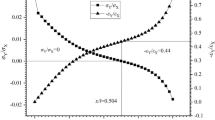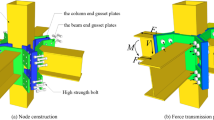Abstract
The response of materials is often nonlinear may be highly dependent upon the load conditions and sometimes is also characterized by a large scatter of experimental results even when nominally equal test specimens are used. Consequently, experimental tests on a large number of specimens are essential in order to develop numerical models and to check their validity. By obtaining a reasonable compromise between the needs of extensive laboratory tests and the high cost of long experimental activities, a test rig for the application of biaxial cyclic loads to structural models was designed and established at the Department of Structural Engineering of the Politecnico di Milano, and a technical description is given here of the test rig, of the control equipment and of the data logging system. A test program developed for bricks, mortar and masonry specimens is then described, with particular emphasis given to the interaction between the experimental activity and the development of a numerical model for masonry. This model is based on homogenization and damage mechanics concepts, and numerical results are compared with experimental data.
Resume
La réponse des matériaux est souvent non linéaire et fortement dépendante des conditions de chargement; parfois, elle est caractérisée par le phénomène d'endommagement et par une grande dispersion des résultats expérimentaux, même lorsqu'on utilise des éprouvettes nominalement identiques. Par conséquent, un grand nombre d'essais est requis pour développer les modèles numériques et vérifier leur validité. Un compromis acceptable entre cette nécessité et le coût important d'une longue activité expérimentale a été obtenu grâce à une machine d'essai pour chargements biaxiaux cycliques, mise au point et installée au Département des Structures, Politecnico di Milano. Afin d'exploiter un grand nombre de conditions de chargement, la machine a été conçue de façon à pouvoir appliquer des charges soit quasi-statiques, soit dynamiques; son équipement électronique peut contrôler forces ou déplacements. Actuellement, on peut utiliser trois vérins pour les chargements en traction ou en compression (jusqu' à ±50000, ±100000 et ±300000 N, respectivement).
Dans l'article, on donne d'abord une description technique de la machine, de son équipement électronique et du système d'acquisition des données. Ensuite, on présente un programme d'essais pour étudier le comportement de la maçonnerie et on discute un modèle numérique fondé sur les concepts de la mécanique de l'endommagement et sur une technique d'homogénéisation. Une loi constitutive a été dérivée pour un matériau homogène équivalent en utilisant les propriétés mécaniques des composants (briques et mortier). La machine conçue pour l'application des efforts biaxiaux sur les éprouvettes de briques et de mortier et sur les panneaux miniaturisés de maçonnerie s'est révélée particulièrement performante dans la validation du modèle, car les dimensions réduites des panneaux offrent la possibilité d'obtenir un grand nombre de données expérimentales à un coût raisonnable et dans un temps assez bref. De plus, puisqu'on ne s'est intéressé qu'au modèle du matériau, les résultats ne sont pas affectés par la taille des éprouvettes utilisées. On présente les essais les plus typiques en portant une attention particulière sur l'interaction entre l'activité expérimentale et le développement du modèle. Finalement, on donne quelques détails sur, l'encadrement théorique et on compare les résultats numériques avec les données expérimentales.
Similar content being viewed by others
References
Maier, G. and Nappi, A., ‘A theory of perfectly no-tension discretized structural system’,Engng Struct. 12 (1990) 229–233.
Panzeca, T. and Polizzotto, C., ‘Constitutive equations for no-tension material’,Meccanica 23 (1988) 88–93.
Biolzi, L., ‘Evaluation of compressive strength of masonry walls by limit analysis’,J. Struct. Engng 114 (1988) 2179–2189.
Dhanasekar, M., Kleeman, P. W. and Page, A. W., ‘Non-linear biaxial stress-strain relations for brick masonry’,J. Struct. Div. ASCE 111 (1985).
Hendry, A. W., ‘Structural Brickwork’ (The Macmillan Press, Hong Kong, 1981).
Lemaitre, J. and Chaboche, J. L., ‘Mécanique des Matériaux Solides’ (Dunod-Bordas, Paris, 1985).
Pande, G. N., Liang, J. X. and Middleton, J., ‘Equivalent elastic moduli for brick masonry’,Computer Geotechnics 8 (1989) 243–265.
Maier, G., Nappi, A. and Papa, E., ‘Damage models for masonry as a composite material: a numerical and experimental analysis,’ in ‘Constitutive Laws for Engineering Materials (ASME Press, New York, 1991) pp. 427–432.
Idem, ‘On damage and failure of brick masonry’, in ‘Experimental and Numerical Methods in Earthquake Engineering’ (Kluwer, Dordrecht, 1991) pp 223–245.
Binda, L., Tiraboschi, C. and Abbaneo, S., ‘Experimental research to characterize masonry materials’, in 2nd Symposium on Testing Stoke-on-Trent, 1993.
Dhanasekar, M., Page, A. W. and Kleeman, P. W., ‘The failure of brick masonry under biaxial stresses’,Proc. Instn Civil Engrs 79 (1985) 295–313.
Binda, L., Gatti, G., Mangano, G., Poggi, C. and Sacchi Landriani, G., ‘The collapse of the Civic Tower of Pavia: a survey of the materials and structure’,Masonry Int. 6 (1992) 11–20.
Sanchez Palencia, E., ‘Non-homogeneous Media and Vibration Theory’ (Springer-Verlag, Berlin, 1980).
Mazars, J., ‘A description of micro-and macroscale damage of concrete structures’,Engng Fracture Mech. 25 (1986) 729–737.
Papa, E., ‘Sulla meccanica, del danneggiamento con particolare riferimento al calcestruzzo’, PhD. Thesis, Politecnico of Milan, 1990.
Page, A. W., ‘A biaxial failure criterion for brick masonry in the tension-tension range’,Int. J. Masonry Constr. 1 (1980) 26–29.
Idem, ‘The biaxial compressive strength of brick masonry’,Proc. Instn Civil Engrs 71 (1981) 893–906.
Idem, ‘The strength of brick masonry under biaxial compression-tension’,Int. J. Masonry Constr. 3 (1983) 26–31.
Bazant, Z. P. and Wu S. T., ‘Rate-type creep law of aging concrete based on Maxwell chain’,Mater. Constr. 7 (1974) 45–60.
Author information
Authors and Affiliations
Rights and permissions
About this article
Cite this article
Papa, E., Nappi, A. A test rig for the application of biaxial cyclic loads to structural models. Materials and Structures 28, 299–307 (1995). https://doi.org/10.1007/BF02473265
Issue Date:
DOI: https://doi.org/10.1007/BF02473265




